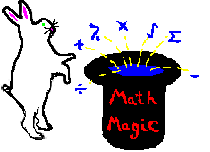

A. When multiplying two numbers that both end in 5, you can do the following from algebra:
(10a + 5) (10b + 5) = 100 (ab + (a + b)/2) + 25, if (a + b) is even
100 (ab + (a + b Ė 1)/2) + 75, if (a + b) is odd
B. Using numbers instead of variables we get the following rules:
If (a + b) is even: 1. Write down 25.
2. Multiply the tenís digits together.
3. Add the tenís digits together and divide by 2.
4. Add step 2 and step 3. Write this result.
If (a + b) is odd: 1. Write down 75.
2. Multiply the tenís digits together.
3. Add the tenís digits together, subtract 1, then divide by 2.
4. Add step 2 and step 3. Write this result.
Ex [1] 35 x 55 =_________.
a) Since 3 + 5 is even, write 25.
b) 3 x 5 = 15.
c) (3 + 5)/2 = 4.
d) 15 + 4 = 19. Write 19.
e) The answer is 1925.
Ex [2] 85 x 75 =_________.
a) Since 8 + 7 is odd, write 75.
b) 8 x 7 = 56.
c) (8 + 7 Ė 1)/2 = 7.
d) 56 + 7 = 63. Write 63.
e) The answer is 6375.
Ex [3] 125 x 155 =_________.
a) Since 12 + 15 is odd, write 75.
b) 12 x 15 = 180. See Multiplying by 15 or Double and Half.
c) (12 + 15 Ė 1)/2 = 13.
d) 180 + 13 = 193. Write 193.
e) The answer is 19375.
C. Note: If you encounter a problem, as in Ex [2], where the difference of the tenís digit is 1, then you can add one to the largest tenís digit and multiply by the remaining tenís digit.
*Ex [2] 85 x 75 =_________.
a) Since 8 + 7 is odd, write 75.
b) 8 + 1 = 9.
c) 9 x 7 = 63. Write 63.
d) The answer is 6375.